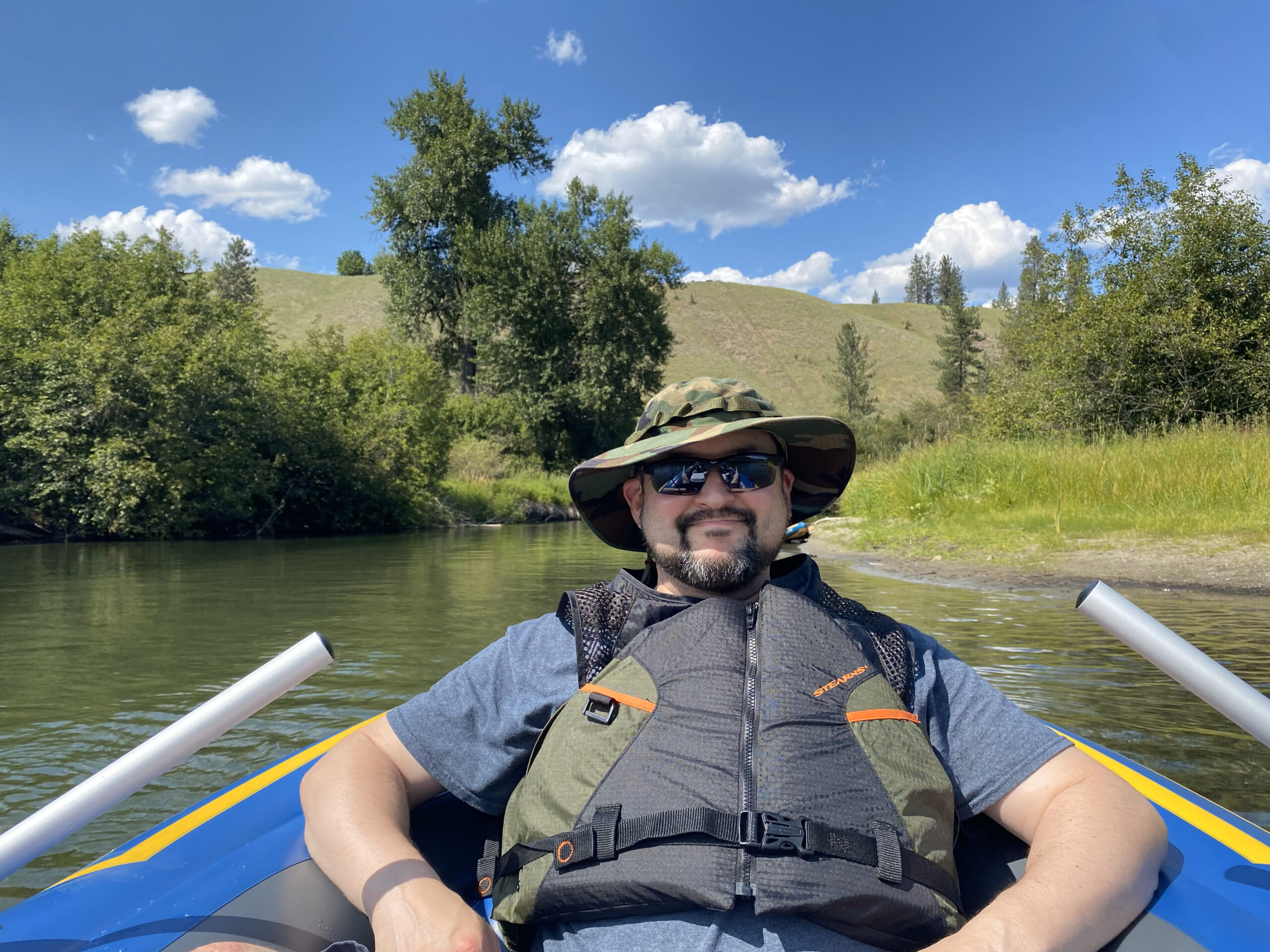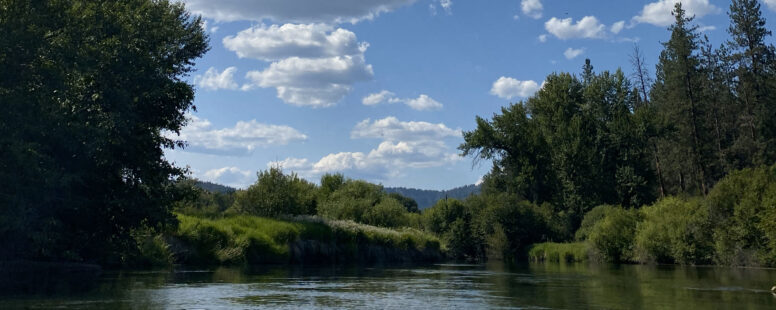A Fourth of July float down the Little Spokane
July 4, 2023, was a fantastically radiant day in sunny Spokane, Washington. It was also a day off of work, and just happened to be the day before my 20th wedding anniversary. I decided to introduce my beautiful bride to some of my wonderful childhood memories by taking her on an adventure down the Little Spokane River. It was especially nice since the kids were staying with the grandparents for the holiday.
Having just relocated to the area, many of the things we needed were either still packed or had been given away in the move. We had to purchase something to float in, and since inner tubes and pool toys are not allowed on the Little Spokane, that meant either a kayak, raft, or stand-up paddle board. I have a collapsible single-seat TuckTec kayak that rolls up and fits in the back seat of my Prius, but we only have the one. Neither of us have ever paddle boarded before, which meant we had to procure a raft for the voyage. Fortunately—though Walmart, Costco, and Fred Meyer were either sold out or didn’t carry them—Big5 came through in the clutch with the Intex Challenger 3-person inflatable raft for only $89.99. Along with a patriotic-themed life vest, a sun hat for the missus, and plenty of water, we were now ready to raft the river.

When I was a kid, we’d put in at the bridge to the Waikiki Springs Nature Preserve since it was just a short walk downhill from my backyard. For this trip though, we put in at the St. George’s Natural Area just past the fish hatchery on Rural Route 5. I should note for first timers that two vehicles are needed unless you have other means of transportation waiting downriver. We took two cars, parked one at Indian Painted Rocks where we intended to get out, then drove to St. George’s in the other one. It was about 3 in the afternoon and the sun was cooking us as we set about unboxing and inflating the raft. After applying a generous amount of sunscreen, assembling and manually blowing up the raft (I brought an electric inflator, but the power source failed), and ensuring our Discover Passes were visible and up to date, we took a quick photo and cast off into the water.
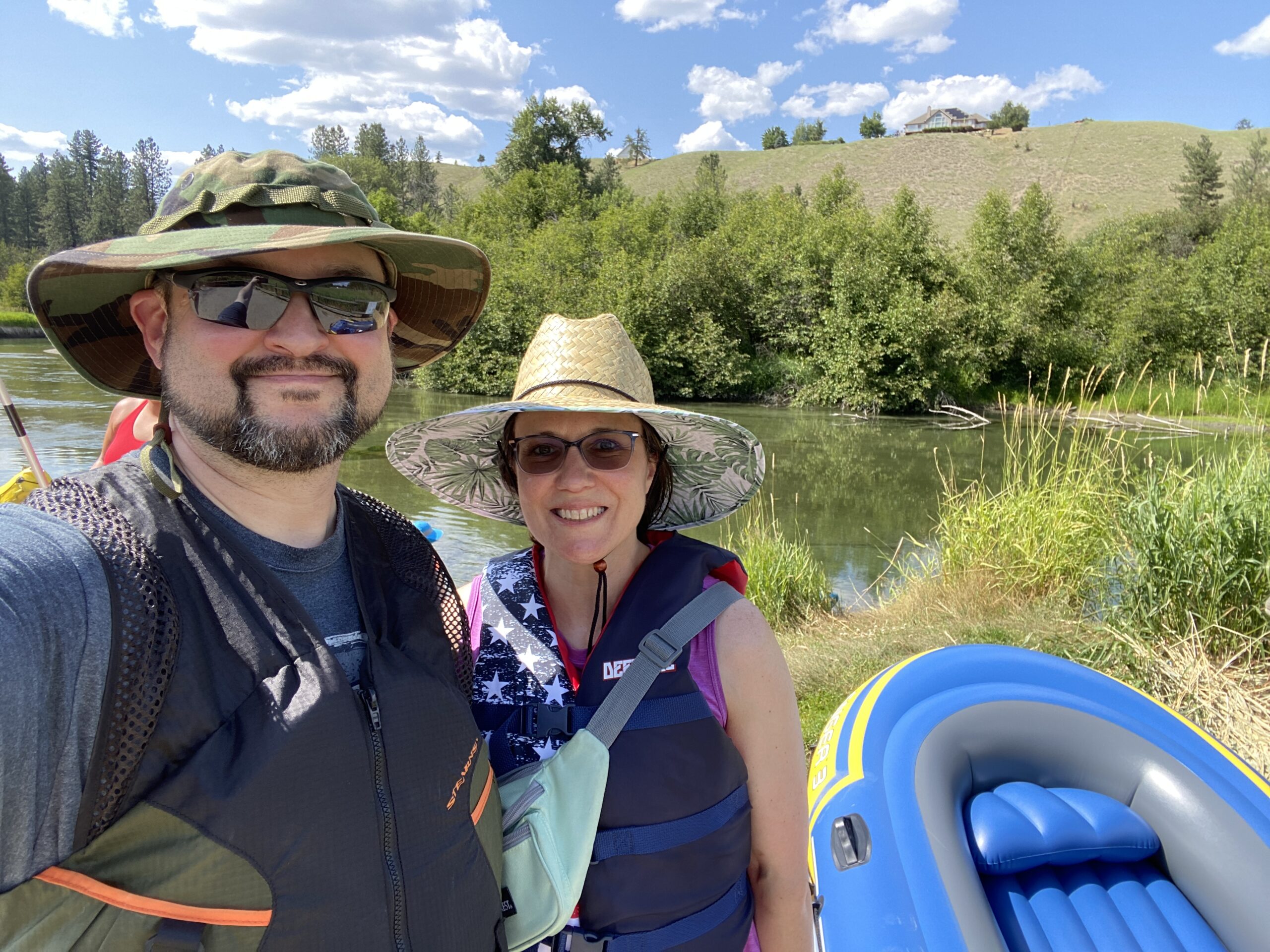
The first thing that’s noticeable is the immediate drop in temperature. It was easily 10-degrees cooler on the water than it was in the dusty parking lot. Plus, when the surface of the water is moving it moves the surrounding air with it creating a lovely breeze. The Little Spokane River cuts a slow and winding path through some of the most beautiful natural areas in eastern Washington. Around the second or third bend, we spotted a deer grazing on a hillside that didn’t seem to give a hoot about us lazily floating past.
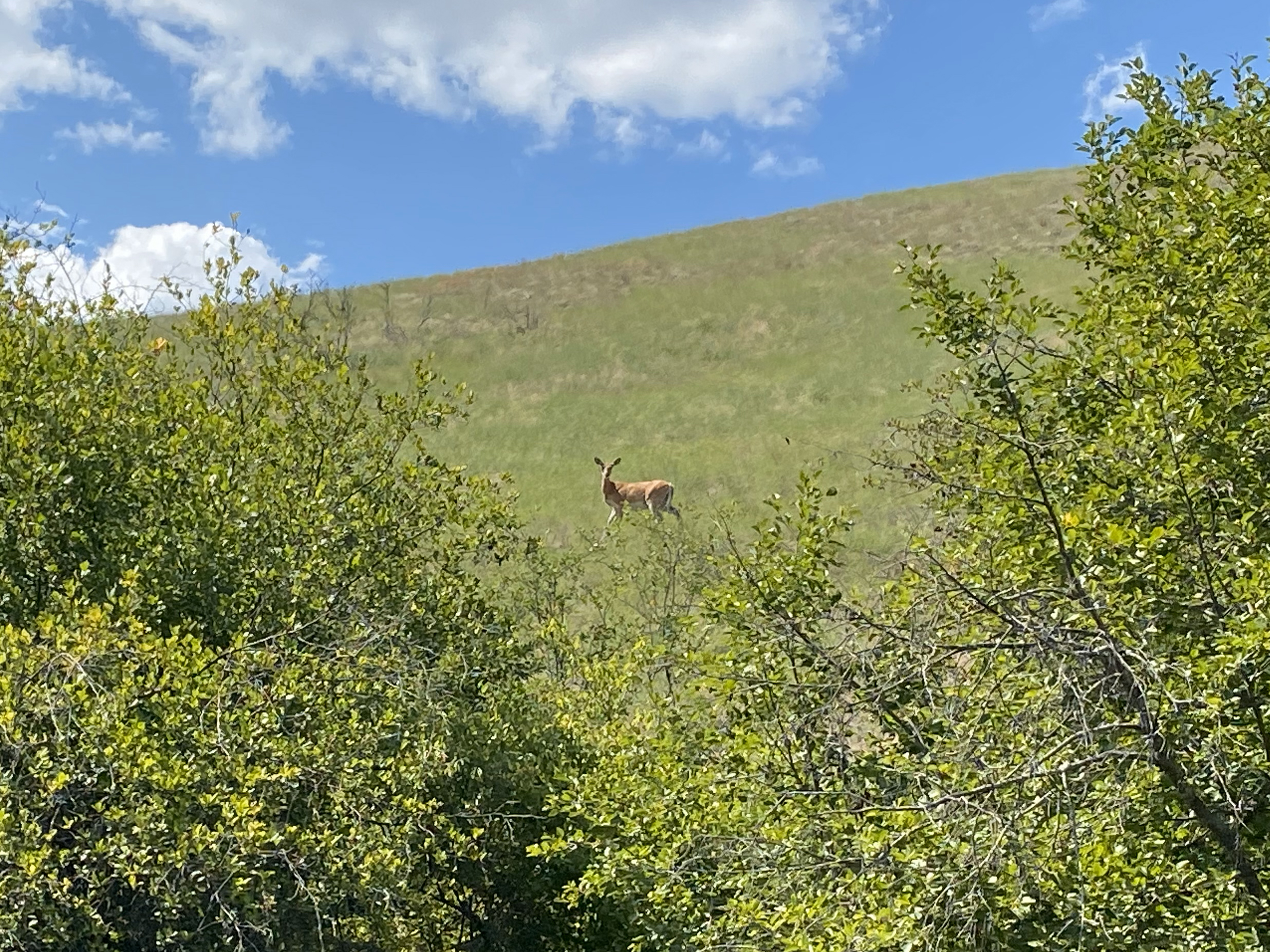
If you’re looking for isolation, this may not be the experience for you. Over time, I’ve learned that any kind of free recreational activity is going to be popular with people who can afford it, and floating down a river is no different. The parking lots at Indian Painted Rocks and St. George’s were nearly at capacity and we were lucky we found spots at both. Adventurers can expect all types at these kinds of recreations, from families with small children to alcohol-affected partyers (despite the drinking prohibition) to teenagers and even the active elderly. Fortunately, by timing things right as we did in the late afternoon, you may be able to find a window between groups that stays with you for most of the 2-hour trip. And sound travels well over water, so conversations you think are private can likely be heard around several bends in either direction (or vice versa).
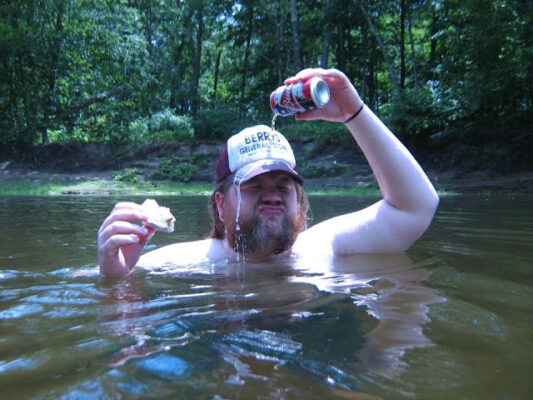
It’s important to note that whoever launches before and after you will likely be your new adventure companions since you’ll be catching up and passing each other for the duration…choose your timing wisely. (We did not encounter the guy in this picture, but a few others nearly as bad.) In addition, flotillas often pull their watercraft ashore at key locations along the route to do things they’re not supposed to, like do shots, smoke marijuana, swim in the river, blast their music, or pee in the bushes.
Besides the infrequent bands of plebeians, other hazards floaters need to watch out for are low-hanging branches, snags, boulders, and gravel bars. There are numerous spots where the river splits into two deep channels on either bank bifurcated by a shallow bar of sand or gravel. Depending on how weighed down your raft, kayak, or canoe is, you might end up high-centered. While maddeningly annoying since it forces you to haul yourself out of a comfortable reclining position into the bracing cool of the river, it’s not by any means a day-wrecker. A few solid tugs toward deeper water and you’ll likely be on your way again in no time.
Branches, snags (sometimes called strainers for their propensity to trap debris and “strain” the water through it), and boulders on the other hand can be downright dangerous. While not abundant, these hazards need to be navigated with care. The river’s current will want to send you in the direction of the overhanging branches at nearly every turn, so positioning yourself in advance to avoid these obstacles is key. Otherwise, you’re left paddling like a madman and spoiling the tranquility. Further, there are both unseen underwater snags as well as those jutting out above the surface. The latter give you plenty of room to steer around or through them, but the only clue to the former is often a fallen tree way off on the shore that extends far out into the river. Fortunately, the water is quite clear, and it helps immensely if you have someone keeping an eye out for these potential raft-poppers. Submerged boulders, on the other hand, leave no clues on shore as to their whereabouts. You’ll be gaily floating along with your head in the clouds only to be startled back to reality by an ominous dark shadow that suddenly appears beneath you. These are typically only a problem if you’ve got your feet in the water or if the water levels are quite low…but stay alert.
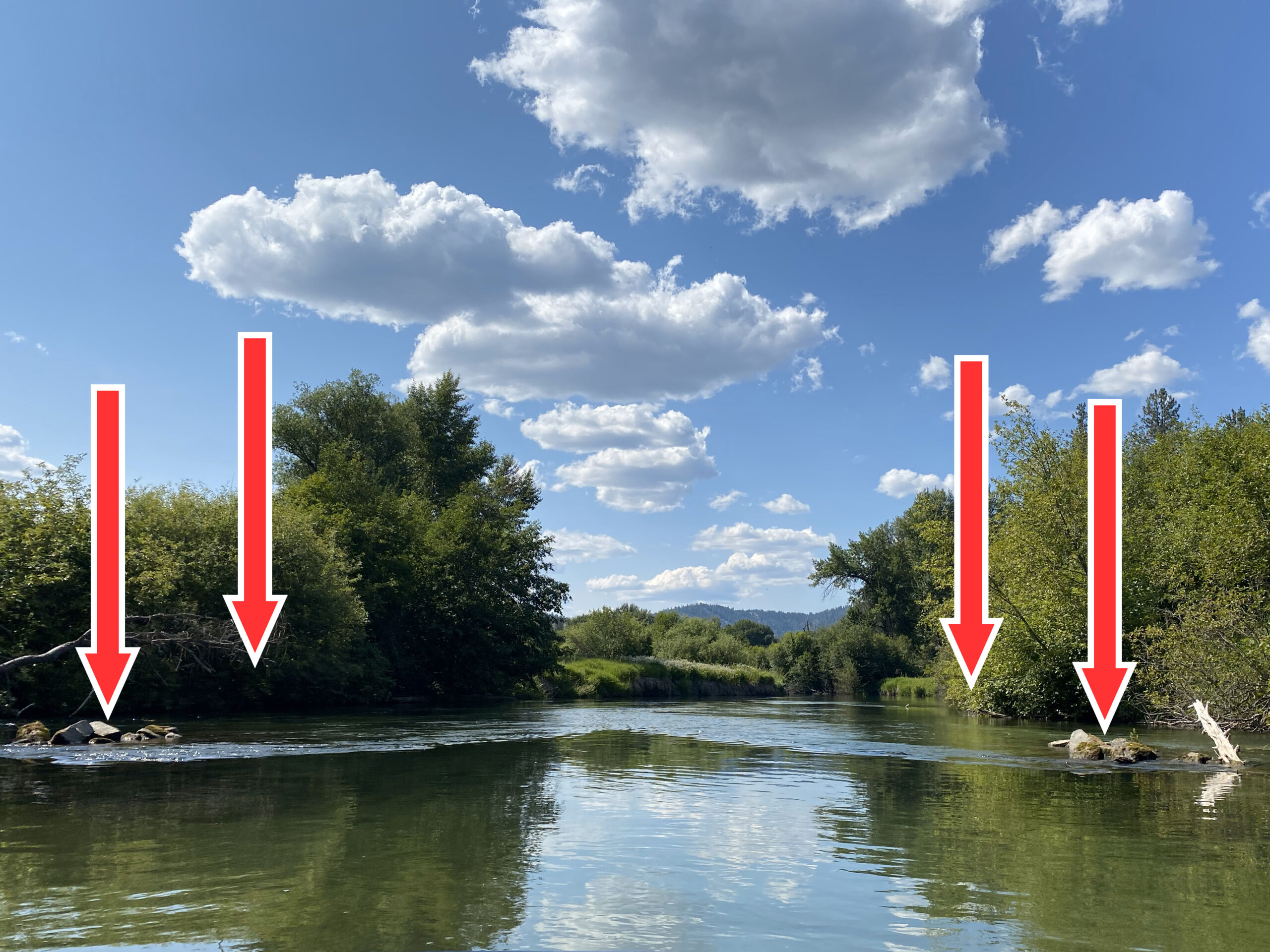
Assuming you make it safely through the narrows and don’t get hung up rounding any oxbows, there are two main places where floaters tend to disembark. The first is a tiny and almost unnoticeable landing at Indian Painted Rocks. This one is much smaller than the launch area at St. George’s and tends to sneak up on you if you’re not paying attention. It’s just a few feet past the second bridge under which you float, and the frequent traffic on Rutter Parkway should be your signal to get ready. It also tends to arrive about 1.5 to 2 hours after launch, depending on how often you stop or get hung up.
For those interested in prolonging the journey (assuming you’ve planned ahead and located a vehicle farther downriver), there is another landing about 1 to 1.5 hours that direction. A small parking lot on Shoemaker Lane is located near where the Little Spokane empties into the big Spokane River in the Nine Mile area. A concrete structure of undetermined purpose on the left bank with a set of small rapids directly in front of you is the signal to make your way to shore. Remember to be courteous when launching and leaving the river to ensure a pleasant experience for everyone.
Easily one of the best things you can do while floating the Little Spokane River is take full advantage of solitary wide spots to simply stop paddling, lay your head back, and let the river take you where it wants to go. Often that means spinning in whimsical circles while being serenaded by swallows, red-winged blackbirds, wood ducks, or even the occasional bald eagle. If you let it, it could be one of the most relaxing things you’ve ever done. It certainly was for me!
